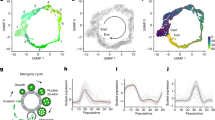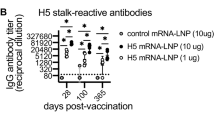Abstract
THE suckling mouse cataract agent (SMCA) is a filterable organism originally isolated from a pooled extract of rabbit ticks (Haemaphysalis leporis-palustris) collected near Atlanta, Georgia in April 1961 (ref. 1). The agent grows to high titre in the eyes and brains when inoculated intracerebrally into newborn mice in which it induces cataract, uveitis and chronic brain infection1–3. SMCA has also been grown to high titre in embryonated hen's eggs, in which it produces a lethal infection in 4–9 d (ref. 1). The agent has not been grown in tissue culture or in artificial media, but growth in a rabbit lens organ culture has been reported4. Stained SMCA-infected tissues failed to show the presence of rickettsiae and, as a result of such negative inferences and other characteristics of the agent3–5, it was considered to be a candidate slow virus6. Within the past few years however, ultrastructural and biological studies showed that a wall-free prokaryote was consistently associated with the acute and chronic disease in mice and with lethality in chick embryos7,8. Although the agent resembled mycoplasmas morphologically, it differed from them in its apparent non-cultivability on conventional mycoplasma medium. We now report that the organism associated with the suckling mouse cataract syndrome is a prokaryote similar to the spiroplasmas—a group of mycoplasmas known previously only from plants and insects.
This is a preview of subscription content, access via your institution
Access options
Subscribe to this journal
Receive 51 print issues and online access
$199.00 per year
only $3.90 per issue
Buy this article
- Purchase on Springer Link
- Instant access to full article PDF
Prices may be subject to local taxes which are calculated during checkout
Similar content being viewed by others
References
Clark, H. F., J. infect. Dis., 114, 476–487 (1964); Prog. Med. Virol., 18, 307–322 (1974).
Clark, H. F., and Karzon, D. T., Proc. Soc. exp. Biol. Med., 131, 693–696 (1969).
Elizan, T. S., Fabiyi, A., and Clark, H. F., Proc. Soc. exp. Biol. Med., 139, 51–55 (1972).
Fabiyi, A., Elizan, T. S., and Pounds, J. E., Proc. Soc. exp. Biol. Med., 136, 88–91 (1971).
Schwartz, J., and Elizan, T. S., Proc. Soc. exp. Biol. Med., 141, 699–704 (1972).
Hotchin, J., Curr. Top. Microbiol. Immun., 40, 33–43 (1967).
Zeigel, R. F., and Clark, H. F., Infect. Immun., 9, 430–443 (1974).
Bastardo, J. W., Ou, D., and Bussell, R. H., Infect. Jmmun., 9, 444–451 (1974).
Davis, R. E., and Worley, J. F., Phytopathology, 63, 403–408 (1973).
Davis, R. E., Worley, J. F., Whitcomb, R. F., Ishijima, T., and Steere, R. L., Science, 176, 521–523 (1972).
Chen, T. A., and Liao, C. H., Science, 188, 1015–1017 (1975).
Williamson, D. L., and Whitcomb, R. F., Science, 188, 1018–1020 (1975).
Cole, R. M., Tully, J. G., Popkin, T. J., and Bové, J. M., J. Bact., 115, 367–386 (1973).
Saglio, P., et al., Int. J. Syst. Bact., 23, 191–204 (1973).
Whitcomb, R. F., Tully, J. G., Bové, J. M., and Saglio, P., Science, 182, 1251–1253 (1973).
Whitcomb, R. F., Williamson, D. L., Rosen, J., and Coan, M., Colloques Inst. natn. Sante Rech. Med. Paris, 33, 275–282 (1974).
Markham, P. G., et al., Ann. appl. Biol., 78, 49–57 (1974).
Williamson, D. L., and Whitcomb, R. F., Colloques Inst. natn. Sante Rech. Med. Paris, 33, 283–290 (1974).
Malogolowkin, Ch., Genetics, 43, 274–286 (1958).
Tully, J. G., Whitcomb, R. F., Bové, J. M., and Saglio, P., Science, 182, 827–829 (1973).
Cole, R. M., Tully, J. G., and Popkin, T. J., Colloques Inst. natn. Sante Rech. Med. Paris, 33, 125–132 (1974).
Pickens, E. G., Gerloff, R. K., and Burgdorfer, W., J. Bact., 95, 291–299 (1968).
Author information
Authors and Affiliations
Rights and permissions
About this article
Cite this article
TULLY, J., WHITCOMB, R., WILLIAMSON, D. et al. Suckling mouse cataract agent is a helical wall-free prokaryote (spiroplasma) pathogenic for vertebrates. Nature 259, 117–120 (1976). https://doi.org/10.1038/259117a0
Received:
Accepted:
Issue Date:
DOI: https://doi.org/10.1038/259117a0
This article is cited by
-
Links and interactions between mycoplasmas and viruses: past confusions and present realities
Archives of Virology (1995)
-
Spiroplasmas from coleopterous insects: New ecological dimensions
Microbial Ecology (1982)
-
Direct isolation in cell-free medium of a spiroplasma fromHaemaphysalis leporispalustris (Acari: Ixodidae) in Maryland
Current Microbiology (1981)
-
Nucleic acid hybridization experiments withSpiroplasma citri and the corn stunt and suckling mouse cataract Spiroplasmas
Current Microbiology (1979)
Comments
By submitting a comment you agree to abide by our Terms and Community Guidelines. If you find something abusive or that does not comply with our terms or guidelines please flag it as inappropriate.



